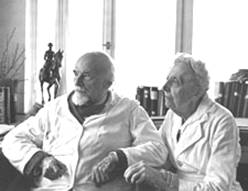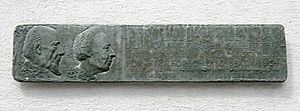Cécile Vogt-Mugnier facts for kids
Quick facts for kids
Cécile Vogt-Mugnier
|
|
|---|---|

Cecile (on right) with her husband Oskar (on left)
|
|
| Born | 27 March 1875 Annecy, France
|
| Died | 4 May 1962 (aged 87) Cambridge, England
|
| Nationality | French |
| Alma mater | Bicêtre Hospital |
| Known for | Neuroanatomy of the thalamus |
| Spouse(s) | Oskar Vogt |
| Children |
|
| Awards | Election to the German Academy of Sciences Leopoldina, National Prize of East Germany |
| Scientific career | |
| Fields | Neuroscience |
| Institutions | Kaiser Wilhelm Institute, now the Max Planck Institute for Brain Research, University of Berlin |
| Doctoral advisor | Pierre Marie |
Cécile Vogt-Mugnier (born March 27, 1875 – died May 4, 1962) was a brilliant French scientist. She was a neurologist, a doctor who studies the brain and nervous system. Cécile worked closely with her husband, Oskar Vogt. They were famous for their detailed studies of the brain's structure, especially how its different parts are built.
Contents
Cécile's Amazing Career
Becoming a Doctor
Cécile Vogt-Mugnier earned her medical degree in Paris in 1900. She studied with a famous doctor named Pierre Marie at the Bicêtre Hospital. Back then, it was rare for women to become doctors. Only about 6% of medical graduates were women, even though they had been allowed to study medicine for 30 years.
Cécile and her husband, Oskar, made important discoveries about how brain fibers develop. This research became the basis for her medical paper. It also started their journey into studying the detailed structure of the brain. Cécile received her official medical license in Berlin in 1920. She was so good that she didn't even need to take exams or do extra training!
Despite her many achievements, Cécile didn't always get the recognition she deserved. For most of her life, she worked without pay. She lived on her husband's earnings. She only had a formal, paid job as a scientist between 1919 and 1937.
Exploring the Brain
Cécile and Oskar Vogt were very interested in finding and describing different areas of the brain's outer layer. They wanted to know exactly which parts of the brain controlled specific functions. To do this, they even used electricity to stimulate the brains of 150 monkeys! They worked with another scientist, Korbinian Brodmann, to map out brain areas.
Their first joint publication was about how the front part of a cat's brain develops its protective covering, called myelination. This discovery made them question some older ideas about how the brain works. They continued to publish important research on the brain's structure and how different parts function.
In 1909, Cécile published her own important work about the Thalamus, a part of the brain that acts like a relay station for sensory information. She showed how nerve fibers connect to this area.
Cécile also rediscovered a condition called 'status marmoratus' in 1911. This condition causes slow, twisting movements, mostly in the hands and face. Another doctor had described it earlier, but Cécile's report brought it to everyone's attention. She continued to lead pioneering work on the neuroanatomy of the thalamus. She also published findings on inherited palsy and a movement disorder called double athetosis.
In 1922, the Vogts came up with the idea of pathoclisis. This describes how certain parts of the brain are more likely to be affected by disease. They studied this in both insects and human brains.
In 1923, the Vogts traveled to Moscow to share their research. They talked about their 25 years of experience studying the brain's structure. After 1933, the Vogts faced challenges from the Nazi government because of their connections with Russian scientists. They strongly defended their scientific freedom. This forced Oskar to retire from their main brain research institute in Berlin. However, they managed to continue their work on a smaller scale in Neustadt.
Starting Research Centers
In 1898, the Vogts started their own private research center in Berlin. It was called the Neurologische Zentralstation. This center later became part of the Berlin University in 1902. This early center was the foundation for the famous Kaiser Wilhelm Institute for Brain Research, which Oskar directed starting in 1914. This institute later became the Max Planck Institute for Brain Research in 1945.
In 1936, Cécile joined her husband in Southern Germany. There, they started another institute called the Institut für Hirnforschung und allgemeine Biologie (Institute of Brain Research and General Biology) in Neustadt.
In 1959, the Vogts founded the Cécile and Oskar Vogt Institute for Brain Research. This institute was later taken over by the University of Düsseldorf in 1964. Today, it holds one of the largest collections of brain slices in the world.
Even though Cécile never held a top position in these institutes, she was very important. A former colleague, Adolf Hopf, said she had a lot of control over how things were run:
"She handled the difficult tasks of managing and funding the institute. She also organized everything inside the institute down to the smallest detail. She made sure that the ways they studied the brain were always of the highest quality. The collection of animal and human brain sections, which was the biggest in the world, was almost like her personal treasure. She knew every single case and every section. Without her help, many staff members would not have been able to use the collection."
Awards and Recognition
In 1924, Cécile Vogt-Mugnier became a co-editor of a science journal called Journal für Psychologie und Neurologie. After 1954, it became the Journal für Hirnforschung (Journal for Brain Research).
In 1932, Cécile received her highest scientific honor. She and Oskar were both chosen to join the German Academy of Sciences Leopoldina. This is the highest academic award in Germany, and many Nobel winners are members. In 1950, she and Oskar received the First Class National Prize of East Germany. She also became a member of the German Academy of Sciences at Berlin. Cécile received honorary doctorates from several universities, including Freiburg, Jena, and the Humboldt University of Berlin.
The Vogt couple became even more well-known after the novel Lenin's Brain (1991) was published. This book mentioned how Oskar Vogt was asked to study the brain of Vladimir Lenin after he died. In 1998, a book was published about Cécile and Oskar's brain research from 1895 to 1927.
Cécile's Personal Life
Early Years
Cécile Vogt-Mugnier was born Augustine Marie Cécile Mugnier in Annecy, France. She lost her father when she was only two years old. A rich aunt paid for her to go to a convent school. But Cécile didn't like the strict rules and left. She went back to live with her mother but kept studying. She prepared for her exams with private teachers and earned a bachelor’s degree in science. At 18, she was one of the very few women accepted into medical school in Paris.
Her Family
Cécile met her future husband, Oskar Vogt, at Bicêtre Hospital. He had come to Paris to work with another famous doctor. They married in 1899, even though Oskar's mother didn't approve. Cécile and Oskar worked together on their research for 60 years. Cécile was usually the main author of their papers.
The Vogts had two daughters, and both became successful scientists:
- Marthe Vogt (1903–2003) was a neuropharmacologist. She studied how medicines affect the brain. She became a Professor at Cambridge and a Fellow of the Royal Society.
- Marguerite Vogt (1913–2007) started by studying genetics in fruit flies. She moved to the US in 1950. She helped develop ways to grow the poliovirus for research. Later, she worked at The Salk Institute for Biological Studies, studying how viruses can change cells and lead to cancer.
Her Personality
Even as a child, Cécile was described as having "an independent and unconventional mind." A neurologist named Igor Klatzo, who worked with Cécile, said she was a kind and open-minded woman. He said she taught him not just about science, but also about enjoying life. He felt she was probably the smartest person he had ever met.
Many people thought Cécile was the more brilliant of the Vogt couple. They believed she came up with the main ideas for their work on the basal ganglia, a part of the brain important for movement. But she often stayed in the background, supporting Oskar and his work.
Another neurosurgeon, Wilder Penfield, met the couple in 1928. He remembered Cécile as a tall woman who often laughed. He said her intelligence often surprised people and left a lasting impression.
Later Life
Later in their careers, the Vogts became interested in genetics. They experimented with insects they collected during their trips to places like the Caucasus and North Africa. Their younger daughter, Marguerite, continued this research for about ten years before moving to California.
Cécile and Oskar continued their work until Oskar passed away in 1959. After his death, Cécile Vogt-Mugnier moved to Cambridge, England, to be with her elder daughter, Marthe. Cécile died there in 1962.
Images for kids



